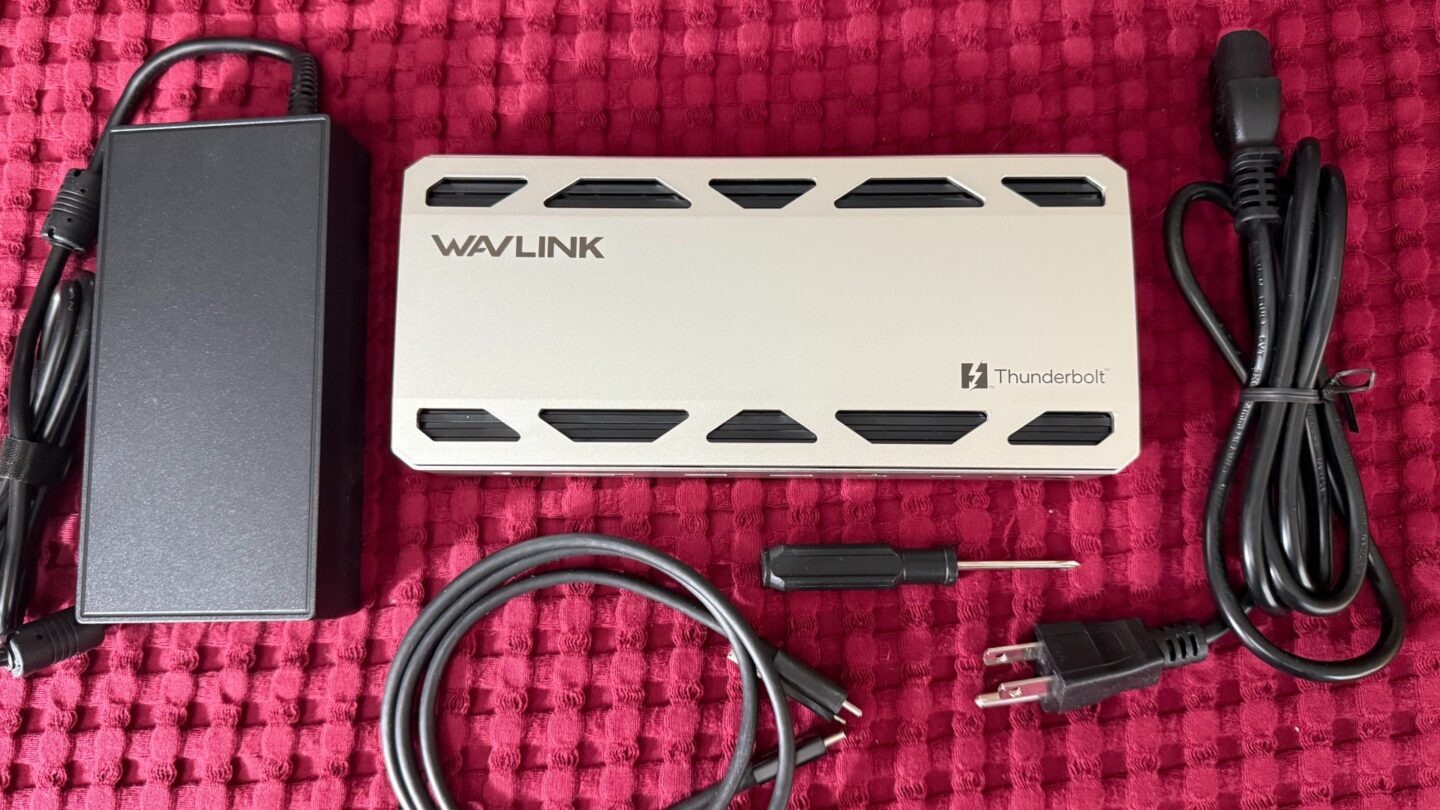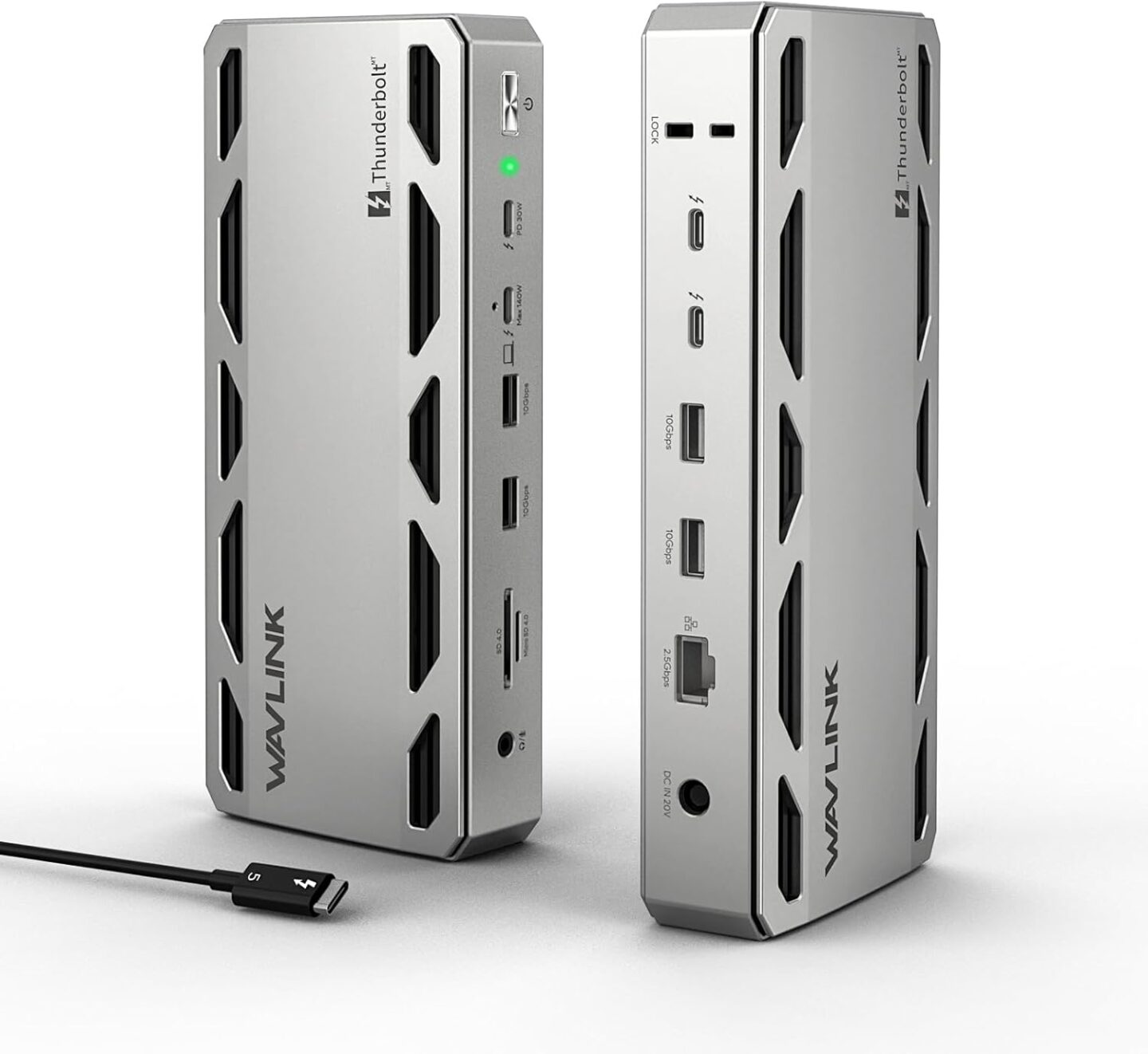The Wavlink Thunderbolt 5 Docking Station (WL-UTD58) heralds the company’s ambitious entry into next-generation connectivity. It offers users impressive charging power and access to remarkable data-transfer speeds in complex computer setups. I tried it in my dual 5K-display M4 MacBook Pro workstation — and found it excellent. Not perfect, but excellent.
Wavlink Thunderbolt 5 dock review
For MacBook Pro users who want to maximize their productivity with high-resolution displays, Wavlink’s powerful dock positions itself as an affordable alternative to premium offerings from CalDigit, OWC and Anker. But it comes with some important caveats for Mac users to consider.
This 12-in-1 Thunderbolt 5 dock offers 120Gbps data transfer, 140W power delivery to a laptop, 8K display support, 2.5G Ethernet port and four USB-A 3.2 Gen 2 ports.
- Blazing fast data transfer
- Plenty of power for laptop
- Supports high resolution displays
- No dedicated HDMI or DisplayPort connection
- Not all max specs apply to Macs
- No active cooling
- Ethernet connection could be faster
Table of contents: Wavlink Thunderbolt 5 dock review
- Impressive power and speed
- MacBook Pro dual 5K reality check
- Design and thermal management
- Value proposition in the Thunderbolt 5 landscape
- Real-world Mac integration considerations
- How the competition distinguishes its features
- Practical workflow applications
- Notable limitations and considerations
- The verdict for Mac users
Impressive power and speed
At the heart of the UTD58 lies Intel-certified Thunderbolt 5 technology, delivering three downstream Thunderbolt 5 ports capable of handling dual displays at up to 8K resolutions at a 60Hz refresh rate, or triple displays at up to 4K resolution and 144Hz refresh rate. That’s bandwidth three times faster than Thunderbolt 4.
It can also handle 80Gbps data transfer. That can change what’s possible for creative professionals working with massive video files or complex workflows. For my purposes, there’s really no file transfer I can come up with that wouldn’t be blindingly fast — as long as I connected the dock to my MacBook Pro using the Thunderbolt 5 cable, and also used a TB5-compatible destination, like an SSD.
The upstream Thunderbolt 5 port provides 140 watts of instant charging capability for compatible laptops, which means even the power-hungry 16-inch MacBook Pro can fast-charge through a single cable connection. This eliminates the traditional cable clutter that has plagued professional desk setups for years. It provided plenty of juice for my 14-inch M4 Pro MacBook Pro (24GB RAM, 512GB SSD).
Beyond Thunderbolt connectivity, the dock includes four USB-A ports running at 10GBps, a 2.5 gigabit Ethernet port for high-speed networking, a card reader supporting speeds up to 312Mbps and an audio combo jack. This port selection addresses the real-world needs of professionals who still rely on legacy USB-A peripherals while future-proofing for upcoming devices. Then again, it lacks dedicated HDMI and DisplayPort connectors.
MacBook Pro dual 5K reality check

Photo: David Snow/Cult of Mac
Here’s where expectations meet Mac hardware limitations. While the UTD58 advertises support for dual displays at resolutions up to 6K at 60Hz for most M-chip Pro and Max MacBooks, the M1, M2, and M3 base models are restricted to single displays at 4K or 6K resolution, according to Wavlink. This isn’t a failing of the dock itself but rather a constraint of Apple’s silicon design.
MacBook Pro models with M4 Pro and M4 Max chips can support dual external displays at 6K/60Hz through Thunderbolt connections. That makes UTD58 an excellent match for these newer machines. The M4 Max variant can even support up to four external displays simultaneously. But achieving that requires connecting additional monitors directly to the MacBook alongside the dock.
For users seeking true 5K dual display support (5120 x 2880 resolution), the technical requirements become more specific. Both the docking station and monitors must support Display Stream Compression version 1.2 and DisplayPort 1.4 specifications. So 5K displays that lack proper DSC support can see resolution degradation from 6K to 4K output.
Real-world Mac integration considerations

Photo: David Snow/Cult of Mac
The Wavlink dock operates plug-and-play with modern macOS versions, requiring no additional drivers for basic functionality. That’s a small advantage over some competitors.
One important consideration involves backward compatibility. Thunderbolt 5 docks work seamlessly with Thunderbolt 4, Thunderbolt 3, USB4 and USB-C devices. That can help protect your investment as you transition between devices over the coming years. This future-proofing aspect carries particular weight given that Thunderbolt upgrade cycles typically span four to five years.
The absence of dedicated HDMI or DisplayPort outputs on the Wavlink dock follows the approach taken by OWC and others, prioritizing flexibility over convenience. Users must employ USB-C to HDMI or DisplayPort adapter cables when connecting displays that lack USB-C inputs. This design philosophy makes sense for modern monitors but adds complexity and potential expense for those with older displays. I happen to use a pair of Alogic Clarity 5K displays that support USB-C connectivity.
Design and thermal management

Photo: David Snow/Cult of Mac
The dock measures 8.5 inches long by 3.5 inches deep and approximately 1 inch high, featuring ventilation on either end. The compact horizontal design contrasts with the cube-style approach taken by competitors like Anker and the elongated profiles of CalDigit’s offerings.
One area where premium docks maintain an advantage involves thermal management. Higher-end options like the Anker Prime incorporate active cooling with built-in fans and sophisticated heatsink designs Macworld, ensuring sustained performance under heavy multi-display and high-bandwidth workloads. Wavlink’s passive cooling approach through ventilation should prove adequate for most users. But sustained maximum loads could present challenges.
Value proposition in the Thunderbolt 5 landscape
At about $300, WL-UTD58 undercuts most competing Thunderbolt 5 docks in price. Anker Prime 14-in-1 Thunderbolt 5 dock retails for about $400. CalDigit’s flagship TS5 Plus commands about $500. Kensington SD5000T5 tends to come in at a lower price, but it can vary.
The price differential becomes significant when considering that many users won’t fully utilize the premium features of top-tier docks. Features like 2.5 gigabit Ethernet and 140W power delivery appear across most Thunderbolt 5 docks regardless of price point, meaning the core functionality remains consistent.
How the competition distinguishes its features
Understanding what separates premium options helps contextualize the Wavlink’s positioning. The Razer Thunderbolt 5 Dock includes an internal M.2 SSD slot supporting drives up to eight terabytes at PCIe Gen 4 speeds, appealing to users who need internal storage expansion. CalDigit’s TS5 Plus delivers 20 ports total with dual USB controllers and 10 gigabit Ethernet, representing the absolute maximum in connectivity options.
Budget-conscious alternatives like the Plugable Thunderbolt 5 dock at $300 offer 11 ports including four Thunderbolt 5 connections, presenting direct competition to the Wavlink offering. The choice between these options often comes down to specific port configurations and brand trust rather than fundamental capability differences.
Practical workflow applications

Photo: Wavlink
For video editors, photographers and creative professionals, the ability to transfer large files at 80Gbps while maintaining dual high-resolution displays transforms daily workflows. Tasks like importing footage from high-speed SSDs while simultaneously editing on dual 6K displays become seamless operations rather than bottlenecked frustrations.
The 2.5 gigabit Ethernet connection proves particularly valuable for professionals accessing network-attached storage or collaborating on shared projects. This represents a meaningful upgrade over standard gigabit connections for bandwidth-intensive workflows, though it falls short of the 10 gigabit networking found on the most expensive docks.
Notable limitations and considerations
The Wavlink dock shares a common limitation with most Thunderbolt 5 options: macOS does not support triple display configurations through docking stations, regardless of the dock’s capabilities. Windows users with Thunderbolt 5 systems can access triple display support, but Mac users remain constrained by Apple’s implementation choices.
Card reader performance, while adequate at 312 megabits per second, lags behind some competitors whose readers have drawn criticism for being slower than expected. Professional photographers rapidly importing thousands of high-resolution images may find this speed limiting compared to dedicated external card readers.
The requirement for manual power button activation represents another minor inconvenience. Unlike some competing docks, the Wavlink requires users to physically press the power button after connecting to power, which can prove awkward depending on desk configuration.
The verdict for Mac users

Photo: Wavlink
Wavlink Thunderbolt 5 Docking Station delivers genuine next-generation connectivity at a competitive price point. That makes Thunderbolt 5 technology accessible to professionals who might otherwise find premium docks too expensive. For MacBook Pro users with M4 Pro or M4 Max chips seeking dual 6K display support alongside comprehensive peripheral connectivity, this dock fulfills its core mission well.
The absence of premium features like active cooling, 10 gigabit Ethernet or integrated storage expansion won’t matter to many users whose workflows don’t demand these capabilities. The money saved versus top-tier alternatives could fund high-quality adapter cables, an external card reader or help you simply remain in your budget.
However, users with older base-model M1, M2, or M3 MacBooks should carefully evaluate whether the Thunderbolt 5 investment makes sense given Apple’s single-display limitations on these machines. Waiting for your next MacBook upgrade before investing in Thunderbolt 5 infrastructure might prove more prudent.
For the specific use case of dual 5K displays with a modern MacBook Pro, verify that your chosen monitors support the necessary Display Stream Compression and DisplayPort standards. This technical compatibility proves just as important as the dock’s capabilities in achieving your desired configuration.
The Wavlink WL-UTD58 represents solid value in the emerging Thunderbolt 5 ecosystem, delivering the speed and connectivity professionals need without the premium pricing of flagship alternatives. While it may lack the polish and some of the advanced features of more expensive options, it accomplishes the fundamental task of expanding your MacBook Pro’s capabilities into a comprehensive workstation through a single cable connection.
This 12-in-1 Thunderbolt 5 dock offers 120Gbps data transfer, 140W power delivery to a laptop, 8K display support, 2.5G Ethernet port and four USB-A 3.2 Gen 2 ports.
- Blazing fast data transfer
- Plenty of power for laptop
- Supports high resolution displays
- No dedicated HDMI or DisplayPort connection
- Not all max specs apply to Macs
- No active cooling
- Ethernet connection could be faster
★★★★☆
Wavlink provided Cult of Mac with a review unit for this article. See our reviews policy, and check out other in-depth reviews of Apple-related items.
![Wavlink Thunderbolt 5 dock blazes through data transfers and brings big laptop power [Review] Wavlink Thunderbolt 5 dock](https://www.cultofmac.com/wp-content/uploads/2025/10/Wavlink-Thunderbolt-5-dock-1020x574.jpg)


